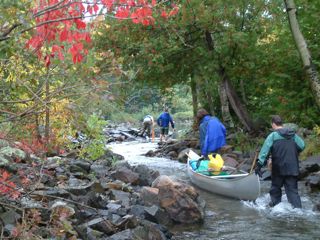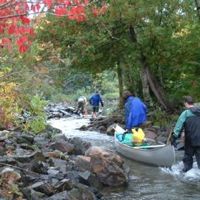One of the best aspects of my work is that I get to meet many talented educators. I’m on the road this week, and I invited two of them to do guest posts. This second post is by James Steckart, Director of Northwest Passage High School. I met Jamie this past summer at the Project Foundry unConference.
~~~~~~
“Hope… which whispered from Pandora’s box after all the other plagues and sorrows had escaped, is the best and last of all things.”
~ Ian Cadwell (The Rule of Four)
 We can disagree whether hope is the best of all things, but let us suppose for a moment that Cadwell speaks the truth. What does hope give the student, the teacher, the parent, the community? Most parents wake up and hope that the lives of their children are better than theirs, whether they live in poverty or in opulence. The community hopes that its members contribute in some positive way to the better of the whole. Most children when they grow have real meaningful dreams of hope. Finally, most teachers hope that their work contributes to the healthy development of the students in their charge.
We can disagree whether hope is the best of all things, but let us suppose for a moment that Cadwell speaks the truth. What does hope give the student, the teacher, the parent, the community? Most parents wake up and hope that the lives of their children are better than theirs, whether they live in poverty or in opulence. The community hopes that its members contribute in some positive way to the better of the whole. Most children when they grow have real meaningful dreams of hope. Finally, most teachers hope that their work contributes to the healthy development of the students in their charge.
This concept of hope is common sense, yet most schools do not understand how they can produce hopeful students. In fact for a majority of students working their way through the a conventional school system, I would argue and data we have would suggest that their overall hope disposition decreases with the more time spent in school. Why would anyone stay in a place where their dreams, questions, and hope are called into question and disparaged?
Let’s look at a school where the concept of hope is front and center. At Northwest Passage High School (NWPHS) the mission of the school is simple: Rekindling our hope, exploring our world, seeking our path, while building our community. Embedding hope into our mission statement, we sought a way to measure this concept to see if we were fulfilling our mission.
NWPHS is a small progressive charter school where half of the day students work with their advisor designing projects that meet state standards, and the other half of the day they are in small seminar classes focused on an interdisciplinary topic involving field research and working with community experts. In addition, the school schedules between 30-45 extended field expeditions to further enhance learning. In a typical year the students travel and conduct research in a variety of urban and wilderness areas throughout the United States and 2-3 select international sites.
Each fall new students to our school complete the Hope Survey for new students, and each spring every student completes the ongoing Hope Survey. The survey measures student engagement, academic press, goal orientation, belongingness, and autonomy and is administered through an internet browser.
This allows us to get a sense of how much and whether hope is being grown. For us the longitudinal data confirmed what we knew in our hearts about our philosophy and methodology of working with high school students. Our ongoing students last year had a high hope score of 50.74 out of 64 possible. What lessons has this given us to share with others?
- First, hope is built when you give students choice and autonomy. At NWPHS, project based learning gives students real choice while they meet Minnesota graduation standards. We track their learning with a sophisticated project management tool called Project Foundry.
- Second, we focus on building positive relationships with youth. We do this through intensive field studies, advisories, and service learning.
- Third, we have faith that students will learn when you help them develop short and long-range goals through the use of continual learning plans and student run conferences which include the student, their advisor and at least one parent. These conferences last 30-45 minutes, and the student leads the discussion on their progress using their continual learning plan as the guide.
- A student devoid of hope is a shell of a human being. They walk around listlessly living each day by the seat of their pants. Our job as educators, parents and community members it to instill a respect of these students and provide opportunities for hope to flourish.
Image: James Steckart


I agree with you that hope is the positive driver that keeps students and teachers going. Teachers train in giving positive and constructive feedback that will build student confidence, they scaffold student learning so that students can achieve success but this is really hard work when you are working in low socio-economic areas especially in a recession.
The school described sounds like one’s ideal school – an adviser for each student, 30-45 field expeditions, authentic learning. From where does the funding come?
Is it a private school? How disappointing that hope decreases as students move through school. Our institutions are in need of change and great that this school is managing to achieve what others can’t.
To Cheryl,
Peter asked me to reply to your comment. Thanks for the kind words. Our school is a public charter school in MN. According to the MN Association of Charter Schools, charter in MN receive 14% less money per student than students attending the traditional district schools.
We receive no tuition and pride ourselves in the fact that we can do all the great things we do solely on the amount the state allocates to us. In addition, students do not have to pay for participation on the expeditions.
How do we do this? We sat down as a team and decided what we value: Expeditions, staff development and technology and funded them accordingly. I like talking to teachers and administrators and tell them that they too can do this within their existing budget, it just takes a lot of sacred cow killing. In some ways our commitment to our vision and mission brushes aside unnecessary bickering. We created a mission that all the stake holders hold passionately.
We also pay competitive wages and have an excellent benefit package, and we don’t over work our staff. They have about 1000 student contact hour during the course of a year, with a portion of that time spent with kid on expedition in the summer time.
We have a lot of professional freedom, are responsible for 30 kids a day, and can see the difference it makes. If want to see it in action, come out to the ProjectFoundry unconference this summer our school is hosting it. I don’t the exact dates but we will post it to our websites. This invitation goes out to anyone who wants to see real dynamic teaching in action.